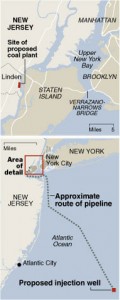![]() Tweet SCS Energy, of Concord, Mass., wants to build a new coal plant in Linden, NJ.
Tweet SCS Energy, of Concord, Mass., wants to build a new coal plant in Linden, NJ.
 According to Kate Galbraith, reporting in the NY Times, “A Plan for U. S. Emissions to Be Buried Under Sea“, 90% of the carbon dioxide will be captured, compressed, pumped thru a 24 inch diameter pipe, approximately 70 miles south-east, past Staten Island, New York, and Middlesex, Monmouth, and Ocean Counties in New Jersey, to a point 25 or 30 miles east of Atlantic City, New Jersey,and injected by a well drilled a mile beneath the sandstone floor of the Atlantic Ocean. The Atlantic is about a half mile deep at that point.
According to Kate Galbraith, reporting in the NY Times, “A Plan for U. S. Emissions to Be Buried Under Sea“, 90% of the carbon dioxide will be captured, compressed, pumped thru a 24 inch diameter pipe, approximately 70 miles south-east, past Staten Island, New York, and Middlesex, Monmouth, and Ocean Counties in New Jersey, to a point 25 or 30 miles east of Atlantic City, New Jersey,and injected by a well drilled a mile beneath the sandstone floor of the Atlantic Ocean. The Atlantic is about a half mile deep at that point.
Gailbraith reports that the plant could cost $5 billion if completed on time and on budget. And it will need $100 million a year in Federal Government subsidies, which amounts to another $4 billion over the plant’s 40 year operating life span.
The carbon sequestration is projected to use 25% to 40% of the energy released from burning coal, so the 750 megawatt plant will be a 450 to 562.5 mw plant. That’s $16 Billion to $20 Billion per gigawatt or $16 to $20 per watt, depending on the overhead costs, of sequestering the carbon.
Solar is roughly $6.50 per watt with no subsidies, no fuel costs, very low maintenance, and no loss in transmission. Offshore Wind is $3.00 per watt, with no fuel costs.
According to the Union of Concerned Scientists, click here for “How Coal Works”, on an annual basis, a 500 mw coal plant will produce 3.5 billion kwh, enough for 140,000 people. To do this it will burn 1.43 million tons of coal, and use 2.2 billion gallons of water and 146,000 tons of limestone. And statistically speaking, one coal miner will die every 2 years per 500 mw coal plant, or one per year for a 1.0 gw plant.
In order to justify the expense, this has to be greater than 1.38 gw to match the cost of Solar power. However, solar has no fuel cost, no waste management cost, and no clean water cost. No people die each day from mining solar energy.
How many tons of coal will the plant burn per day?
How many tons of carbon dioxide will it pump under the ocean floor?
According to the Union of Concerned Scientists, a 1.0 gw plantwill also produce:
- 7.4 million tons of carbon dioxide,
- 20,400 tons of nitrogen oxide,
- 20,000 tons of sulphur dioxide,
- 1,440 tons of carbon monoxide,
- 1,000 tons of small particules,
- 440 tons of hydrocarbons,
- 250,000 tons of ash,
- 3824000 tons of sludge containing arsenic, lead, and uranium.
If it pumps 90% of the carbon dioxide, that’s 6.6 million tons per year, 18,246 tons per day.
What are the costs of building and maintaining a 2 foot wide pipe that extends 70 miles out along the ocean floor to a depth of 2640 feet? And what are the costs of drilling and maintaining a well that starts at a depth of 2640 feet and goes down another 5280 feet under the ocean floor?
Where exactly will the carbon dioxide go? I never studied geology, but as far as I know, the earth, under the sea floor, is not composed of vacuum. Are there caves down there waiting to be filled with 18 thousand tons per day of carbon dioxide? If so, can we store radioactive wastes down there too? And is that where Jimmy Hoffa is buried?
Carbon dioxide is a gas at temperatures above -78 o C or -108 o F or pressures less than 5.1 atmospheres. What is the cost in terms of money and energy of cooling and pressurizing carbon dioxide such that it liquefies? How much does it cost to keep the carbon dioxide a liquid while it is pumped 70 miles out and 1.5 miles beneath the surface of the ocean?
What happens if the pipe breaks? If there’s a leak? Carbon dioxide in water is carbonic acid – how much will 18 thousand tons of carbon dioxide – one day’s worth – change the pH of the ocean? What will that do to the habitat? What will it do to the fish? The fishermen? Will it turn the beaches into an acid bath?
What are the national security ramifications of this design?
What about the mercury, lead, uranium, arsenic, and other toxic byproducts of burning coal?
What about the environmental effects of blasting mountains out of existence to get to the carbon already sequestered in the form of coal?
Is this sustainable? Wouldn’t it be easier, cheaper, and safer to build solar power and wind power installations? What is the best and sustainable ways to generate electricity?
Rube Goldberg was a great engineer. But his designs were not meant to be built.This plant seems to be more Rube Goldberg than good engineering.